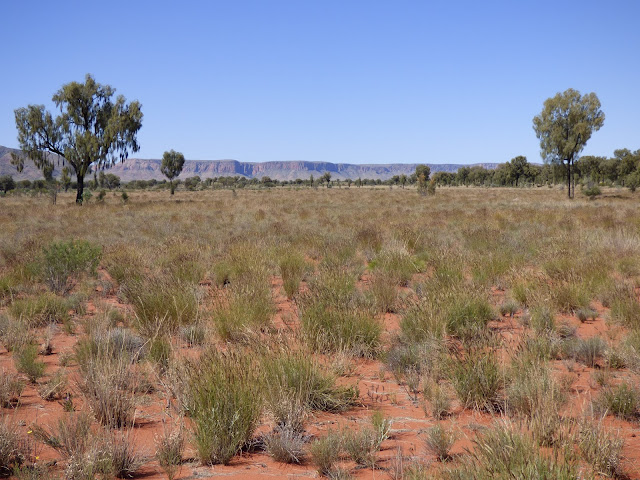HAATST BLUFF - 3
Recently, we took a drive to Mt Liebig via a road 'less used' and returned via the main road through Papunya. When I say 'main road' it is a main road for this area but is not sealed and less than 10 vehicles per hour. From Ikuntji (Haasts Bluff) we crossed a creek lined with white gums and then past the communities airstrip (again a gravel runway) and off into the vast empty spaces west of here. Initially we drove through reasonably flat red sandy country. The weathered ranges to our north and south dictated a westerly path. No traffic, no mobile service, no radio stations, no roadhouses, no traffic signs, no road side service, no speed cameras, no 'civilisation' many would say - yet there is a beauty here and we enjoyed a great day. Come for a drive with us?
Double clicking on the photos will enlarge them.
The track had recently been graded so made for pleasant driving. This area is sometimes referred to as the 'Red Centre'. The colour of the track below explains why.
The further west we went the mulga scrub gave way to desert oaks as the colour of the sand becomes less red.
And then some low sand dunes. The photo below is taken from on top of a dune with desert oaks in the foreground and ranges in the distant.
Windmills - wind driven pumps used to draw water from bores to provide water for cattle. Now days solar technology has largely taken over leaving scenes like the one below. The grass in this photo is buffel, introduced by the pastoral industry. Sadly, it has choked out the native grasses in many areas.
Turning north the track weaves through this range.
To the south east of Ikuntji (Haasts Bluff) is Goose Bluff. It was formed by a meteor. Tourists can drive into the crater and view the weathered walls from within. We have only seen it from the outside but it is on the 'to do list'.
The evening skies are generally clear here so we got a great view to the recent 'super full moon' - the moon being the closest to earth for many years in it's elliptical orbit and the full moon stage of the lunar month both coinciding.
Amazingly, in the midst of a place that can be extremely harsh are found delicate blooms of great beauty.
Below - we spotted some Black-Faced Woodswallows near a stand of desert oaks. In flight they display two white spots on the underside of their black tails.
Until next time, be blessed and be a blessing.
Bryan and Nancy
Recently, we took a drive to Mt Liebig via a road 'less used' and returned via the main road through Papunya. When I say 'main road' it is a main road for this area but is not sealed and less than 10 vehicles per hour. From Ikuntji (Haasts Bluff) we crossed a creek lined with white gums and then past the communities airstrip (again a gravel runway) and off into the vast empty spaces west of here. Initially we drove through reasonably flat red sandy country. The weathered ranges to our north and south dictated a westerly path. No traffic, no mobile service, no radio stations, no roadhouses, no traffic signs, no road side service, no speed cameras, no 'civilisation' many would say - yet there is a beauty here and we enjoyed a great day. Come for a drive with us?
Double clicking on the photos will enlarge them.
The track had recently been graded so made for pleasant driving. This area is sometimes referred to as the 'Red Centre'. The colour of the track below explains why.
The further west we went the mulga scrub gave way to desert oaks as the colour of the sand becomes less red.
And then some low sand dunes. The photo below is taken from on top of a dune with desert oaks in the foreground and ranges in the distant.
Windmills - wind driven pumps used to draw water from bores to provide water for cattle. Now days solar technology has largely taken over leaving scenes like the one below. The grass in this photo is buffel, introduced by the pastoral industry. Sadly, it has choked out the native grasses in many areas.
The native grass on the plain below have not been impacted by buffel yet. National Park and Indigenous land care groups are seeking to limit the spread of buffel.
The desert oak provides good shade from the relentless summer sun. As you can see in most of the photos there is a big blue cloudless sky which in summer results high daytime temperatures.Turning north the track weaves through this range.
To the south east of Ikuntji (Haasts Bluff) is Goose Bluff. It was formed by a meteor. Tourists can drive into the crater and view the weathered walls from within. We have only seen it from the outside but it is on the 'to do list'.
The evening skies are generally clear here so we got a great view to the recent 'super full moon' - the moon being the closest to earth for many years in it's elliptical orbit and the full moon stage of the lunar month both coinciding.
Amazingly, in the midst of a place that can be extremely harsh are found delicate blooms of great beauty.
Below - we spotted some Black-Faced Woodswallows near a stand of desert oaks. In flight they display two white spots on the underside of their black tails.
Until next time, be blessed and be a blessing.
Bryan and Nancy
















Comments